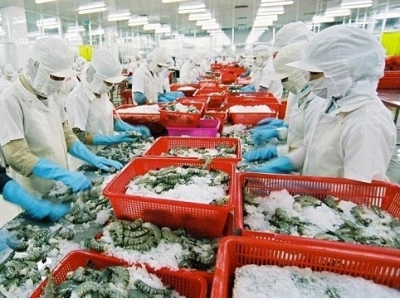Chinese market promising for Vietnams shrimps as exports surge 30%

Vietnam’s shrimp exports to China rose 30% in the first half of 2017, reaching almost US$283 million, making it a potential destination to replace the established markets where the export of Vietnam’s seafood is struggling.
According to Vasep, an association of seafood producers and exporters, Vietnam’s shrimp exports to China made a strong recovery in the second quarter, surging 57.6% following a fall of 3.9% in the three months previous.
In 2017 China imported over US$777 million worth of shrimp, mainly from Argentina and Vietnam, with respective rises of 224.3% and 176.7%, while its imports from Ecuador and India dropped by 48% and 27.6% respectively.
China’s imports are mainly in the form of frozen warm water shrimp, followed by frozen cold water shrimp.
The proportion of warm water shrimp is stable, while that of cold water shrimp is on the rise, forcing Vietnam to compete with not only exporters in Asia but also with cold water shrimp providers from Argentina and Canada.
However, thanks the ASEAN-China Free Trade Agreement, Vietnam can enjoy tariff preferences when exporting shrimp to the world’s second largest economy.
With a population of more than 1.3 billion people and a growing demand for high-quality food, China has become a promising market for seafood exporters in recent years.
It is projected that Vietnam’s shrimp exports to China, in the second half of the year, will continue to grow given China’s shrinking output as a result of its policy to boost imports for re-export.
In addition, the transport cost for the Chinese market is lower, while there are no technical barriers and unfair duty impositions as in the US market.
Related news
 Red River Delta promotes hi-tech agricultural production
Red River Delta promotes hi-tech agricultural production The application of high technologies in agricultural production in the region is still facing a range of inadequacies which has not brought
 Safeguard duty on fertilizer imports may cause rice production costs to surge
Safeguard duty on fertilizer imports may cause rice production costs to surge The upcoming imposition of a temporary safeguard duty on DAP and MAP fertilizer imports into Vietnam will send fertilizer prices rising
 Forum promotes vegetable and fruit trade between Vietnam and China
Forum promotes vegetable and fruit trade between Vietnam and China A forum in the northern border province of Lang Son on August 11, to discuss the necessary measures to promote vegetable and fruit trade between Vietnam